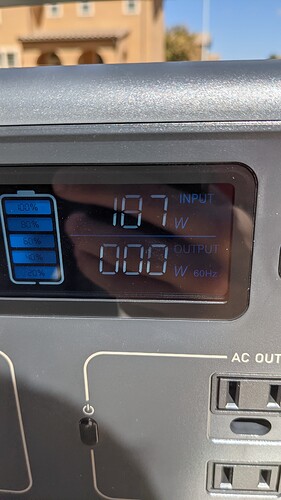Not impressed with the 12 volt car charging on mine. Like Scott noted the most I can get is about 74 watts incoming which translates into a 9 hour actual charge time, Bluetti is advertising 6 hours. My AC50s which is about the same capacity can do it in 6 1/4 hours at about a 100 watts.
Hey Scott,
Excellent writeup! I also only got about 80W via the DC input port charging off of 14.2V from my battery, but per your suggestion I added a 12v to 24v step up, and am now getting almost 190W from the battery/alternator!
Now excuse my ignorance, but I do have a follow up question. If per ohms law for power (P=VI), then why does the wattage increase so significantly? If the power source (the battery) stays the same, should current be more or less cut in half by doubling the voltage?
Your 12 volt current (amps) is doubling to provide the increased wattage. Wiring and connector size has to be sufficient for a continuous 20 amp draw
It is all 10 and 12AWG wiring which should be good for 20A, though the max output on the converter is 10A. I also fused both sides (input/output) at 20A just in case, and the unit itself has over/under volt and fault protection. I’m definitely going to run some tests though before installing it under my hood.
I would go with 10 ga on the input and you can do 12 or 14 ga. on the output side not problem. The closer to the battery is to the converter the better to minimize losses.
Perfect! Thanks for all the help Scott I really appreciate it. I think the input is 12awg and hardwired into the converter.
Also, is it possible to combine a 12V charging source and a 100W solar input together to increase the charge wattage?
No there is not. The two sources you mention operate at different voltages and the built in charge controller will not function
Okay gotcha. Appreciate all of the info!
Nice job @Scott-Benson . Can’t believe I’m just now seeing this write up. I decided on EB55 after my research but probably would have saved time had I seen this review. Thx. Mine was suppose to arrive today but now probably monday
Thank you for the kind words. It would be great if there was a consolidated topic just for product tebiees
95% battery output through the inverter is unbelievably good. Most inverter is at most 90% efficient. This means the actual usable battery may be larger than rated. In fact, 80% is what I would expect, and 85-90% is excellent. 90%+ through an AC load at C/3 is unreal.
It is strange that the DC 12-14V charging performance is poor. I wonder how many amps it is drawing when charging at 12V, is it only drawing day 3-4A?
The load fan is disappoint. I have a Jackery 1500 which is fine but I can’t use it for anything near my bed (no dice for any CPAP users) as the fan would randomly come on at full speed and is super loud. This seems like it is similar.
Yeah Scott must have got an exceptional one, mine consistently gets around the expected 80% range of 430wh.
Keep in mind I used a fairly steady load of 155 watts AC. If you test with a smaller load running for additional time, inverter overhead draw will decrease the usable watts. At the opposite spectrum a very large load will yield somewhat lesser yields as well. I chose my load amount simply because it is what my tv draws and is a decent wattage amount.
I’ll try a similar steady load and see what I get. My results were mostly with a modern kitchen fridge and a couple DVRs which averaged around 170wh. The modern fridges don’t have the big current spikes like the older ones but its possible it might have affected the results somewhat even though a wh is a wh.
Darn can’t use the D050S w/ the EB55 according to Bluetti
That is because the output voltage exceeds the input max voltage of the EB55 and the EB70
Do you mind sharing how you added the step up converter? So far Google searches have been unfruitful. I assume I’m using incorrect search terms. Is there a video you could point me to?
You would connect a 12V to 24V DC 15 amp output step up converter (amazon) to your vehicle battery. You would have cables from the vehicle battery to the converter and then the converter output would connect your EB55 DC charging input cable. This will give you about 200 watts of charge and will consume a little over 20 amps of power from your vehicle alternator or battery. You can utilize a large manual switch or use a switched relay to power the unit anytime you turn your vehicle key on.
I accidentally fell asleep w/ b230 charging a tablet and a charger (low demand devices) and when I woke up this morning the b230 was off. So sometime in the night it shut off. Both devices at 100% and the b230 still at 5 green dots. Not an official test just and observation and I think answered my own question.
